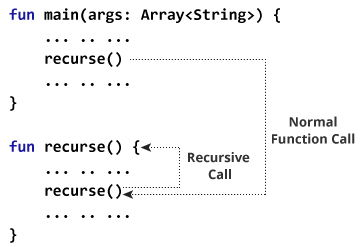Kotlin Recursion (Recursive Function) and Tail Recursion
In this article, you will learn to create recursive functions; a function that calls itself. Also, you will learn about tail recursive function.
A function that calls itself is known as recursive function. And, this technique is known as recursion.
A physical world example would be to place two parallel mirrors facing each other. Any object in between them would be reflected recursively.
How does recursion work in programming?
fun main(args: Array<String>) {
... .. ...
recurse()
... .. ...
}
fun recurse() {
... .. ...
recurse()
... .. ...
}
Here, the recurse() function is called from the body of recurse() function itself. Here’s how this program works:

Here, the recursive call continues forever causing infinite recursion.
To avoid infinite recursion, if…else (or similar approach) can be used where one branch makes the recursive call and other doesn’t.
Example: Find factorial of a Number using Recursion
fun main(args: Array<String>) {
val number = 4
val result: Long
result = factorial(number)
println("Factorial of $number = $result")
}
fun factorial(n: Int): Long {
return if (n == 1) n.toLong() else n*factorial(n-1)
}When you run the program, the output will be:
Factorial of 4 = 24
How this program works?
The recursive call of the factorial() function can be explained in the following figure:

Here are the steps involved:
factorial(4) // 1st function call. Argument: 4 4*factorial(3) // 2nd function call. Argument: 3 4*(3*factorial(2)) // 3rd function call. Argument: 2 4*(3*(2*factorial(1))) // 4th function call. Argument: 1 4*(3*(2*1)) 24
Kotlin Tail Recursion
Tail recursion is a generic concept rather than the feature of Kotlin language. Some programming languages including Kotlin use it to optimize recursive calls, whereas other languages (eg. Python) do not support them.
What is tail recursion?
In normal recursion, you perform all recursive calls first, and calculate the result from return values at last (as show in the above example). Hence, you don’t get result until all recursive calls are made.
In tail recursion, calculations are performed first, then recursive calls are executed (the recursive call passes the result of your current step to the next recursive call). This makes the recursive call equivalent to looping, and avoids the risk of stack overflow.
Condition for tail recursion
A recursive function is eligible for tail recursion if the function call to itself is the last operation it performs. For example,
Example 1: Not eligible for tail recursion because the function call to itself n*factorial(n-1) is not the last operation.
fun factorial(n: Int): Long {
if (n == 1) {
return n.toLong()
} else {
return n*factorial(n - 1)
}
}
Example 2: Eligible for tail recursion because function call to itself fibonacci(n-1, a+b, a) is the last operation.
fun fibonacci(n: Int, a: Long, b: Long): Long {
return if (n == 0) b else fibonacci(n-1, a+b, a)
}
To tell compiler to perform tail recursion in Kotlin, you need to mark the function with tailrec modifier.
Example: Tail Recursion
import java.math.BigInteger
fun main(args: Array<String>) {
val n = 100
val first = BigInteger("0")
val second = BigInteger("1")
println(fibonacci(n, first, second))
}
tailrec fun fibonacci(n: Int, a: BigInteger, b: BigInteger): BigInteger {
return if (n == 0) a else fibonacci(n-1, b, a+b)
}When you run the program, the output will be:
354224848179261915075
This program computes the 100th term of the Fibonacci series. Since, the output can be a very large integer, we have imported BigInteger class from Java standard library.
Here, the function fibonacci() is marked with tailrec modifier and the function is eligible for tail recursive call. Hence, the compiler optimizes the recursion in this case.
If you try to find the 20000th term (or any other big integer) of the Fibonacci series without using tail recursion, the compiler will throw java.lang.StackOverflowError exception. However, our program above works just fine. It’s because we have used tail recursion which uses efficient loop based version instead of traditional recursion.
Example: Factorial Using Tail Recursion
The example to compute factorial of a number in the above example (first example) cannot be optimized for tail recursion. Here’s a different program to perform the same task.
fun main(args: Array<String>) {
val number = 5
println("Factorial of $number = ${factorial(number)}")
}
tailrec fun factorial(n: Int, run: Int = 1): Long {
return if (n == 1) run.toLong() else factorial(n-1, run*n)
}When you run the program, the output will be:
Factorial of 5 = 120
The compiler can optimize the recursion in this program as the recursive function is eligible for tail recursion, and we have used tailrec modifier that tells compiler to optimize the recursion.
Python Example for Beginners
Two Machine Learning Fields
There are two sides to machine learning:
- Practical Machine Learning:This is about querying databases, cleaning data, writing scripts to transform data and gluing algorithm and libraries together and writing custom code to squeeze reliable answers from data to satisfy difficult and ill defined questions. It’s the mess of reality.
- Theoretical Machine Learning: This is about math and abstraction and idealized scenarios and limits and beauty and informing what is possible. It is a whole lot neater and cleaner and removed from the mess of reality.
Data Science Resources: Data Science Recipes and Applied Machine Learning Recipes
Introduction to Applied Machine Learning & Data Science for Beginners, Business Analysts, Students, Researchers and Freelancers with Python & R Codes @ Western Australian Center for Applied Machine Learning & Data Science (WACAMLDS) !!!
Latest end-to-end Learn by Coding Recipes in Project-Based Learning:
Applied Statistics with R for Beginners and Business Professionals
Data Science and Machine Learning Projects in Python: Tabular Data Analytics
Data Science and Machine Learning Projects in R: Tabular Data Analytics
Python Machine Learning & Data Science Recipes: Learn by Coding
R Machine Learning & Data Science Recipes: Learn by Coding
Comparing Different Machine Learning Algorithms in Python for Classification (FREE)
Disclaimer: The information and code presented within this recipe/tutorial is only for educational and coaching purposes for beginners and developers. Anyone can practice and apply the recipe/tutorial presented here, but the reader is taking full responsibility for his/her actions. The author (content curator) of this recipe (code / program) has made every effort to ensure the accuracy of the information was correct at time of publication. The author (content curator) does not assume and hereby disclaims any liability to any party for any loss, damage, or disruption caused by errors or omissions, whether such errors or omissions result from accident, negligence, or any other cause. The information presented here could also be found in public knowledge domains.

